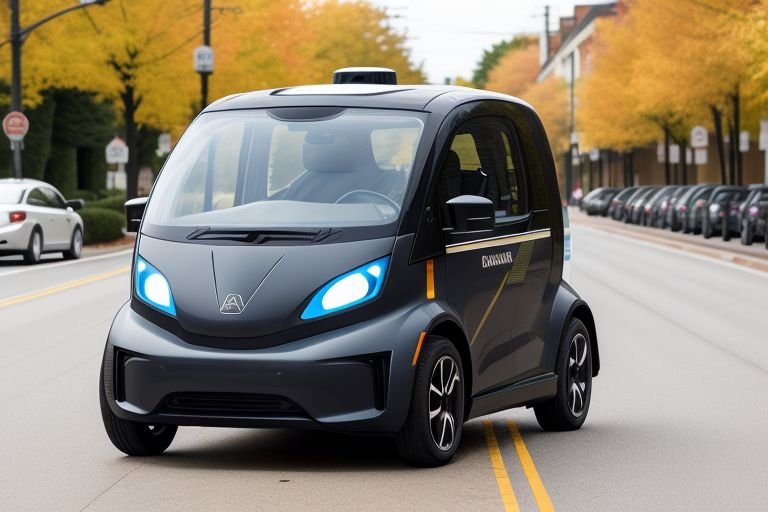
Autonomous Delivery Vehicles Hit the Roads In Major US Cities
A new phase of urban delivery is emerging as autonomous vehicles start arriving in cities across the United States. This revolutionary progress indicates a major break in transportation evolution and logistics that will change how goods reach consumers and businesses.
In recent times some businesses launched trial initiatives and broadened their operations by sending self-driving delivery cars to metropolitan areas like Austin and San Francisco. Autonomous vehicles of all sizes are currently moving through city roads and delivering packages and meals right to customers’ homes.
The company Nuro is gaining attention for its R2 delivery vehicle. Recently the company introduced a larger service footprint in Houston, Texas where it began operating in 2019. In certain neighborhoods across the nation,Nuro’s vehicles act as small delivery vans and deliver groceries and medications to people. As a result of the program’s achievements Nuro ventured into discussing alliances with major food and retail outlets with the goal of widening its impact on the delivery market.
The autonomous driving technology company owned by Alphabet is testing its delivery service in Phoenix Arizona. By leveraging its past with self-driving taxis Waymo has transformed its tech for delivery and commenced the use of Chrysler Pacifica minivans for local delivery. The organization integrates the capability of autonomous driving with the ability to tackle larger delivery tasks to revolutionize both local and long-distance logistics.
In select parts of Seattle and Washington D.C., Amazon has been evaluating its autonomous delivery machines quietly. As an example of last-mile service possibilities the Amazon Scout transports goods to Prime members safely and efficiently in city environments.
As the global pandemic lifts demand for contactless delivery options so too do autonomous delivery vehicles rise. Home delivery convenience is familiar to buyers and firms aim to seek out improved and economical solutions to satisfy this request. Autonomous delivery solutions hold great promise by allowing for lower costs in delivery and greater efficiency in addition to perpetual service freed from human constraints.
The launch of these vehicles has met several challenges. In several jurisdictions regulatory issues persist as lawmakers and city officials attempt to incorporate autonomous vehicles into their existing transportation networks. Doubts about whether the technology is prepared for extensive use in complex metropolitan areas remain.
Autonomous delivery vehicle operators have set up drastic safety systems and engage with local government to verify that traffic laws and safety guidelines are met. A great number of vehicles have advanced detecting tools and visual aids that help them recognize and react promptly to hazards and pedestrians.
The adoption of autonomous delivery vehicles is boosted by their ecological benefits. Several of these vehicles run on electromagnetism that plays a role in decreasing emissions and reflects cities’ environmental objectives. In cities grappling with congestion and environmental concerns the idea of cleaner and less noisy deliveries resonates with city planners and advocates for sustainability.
The transition to autonomous delivery brings important financial effects. Although issues of job displacement in the conventional delivery domain exist supporters maintain that this technology can create improved chances in various areas such as vehicle repair and fleet oversight. Furthermore the higher productivity and lower expenses related to self-driving delivery may drive down costs for shoppers and introduce innovative business approaches for shops and dining establishments.
When these vehicles emerge more frequently on city roads their public acceptance and views will be essential for their success. Feedback varies; while a few residents are keen on the technology many are doubtful or anxious about its implications for safety and privacy. Many cities are conducting programs to make residents aware of the vehicles and respond to any worries.
The race for market share in autonomous delivery is rising as old carmakers join tech firms and new companies. With Agility Robotics,Ford jointly designed a bipedal robot called Digit to handle delivery needs of a self-driving vehicle to a customer’s door.
Forecasters expect the autonomous delivery industry to thrive quickly in the future. When technology progresses and regulations advance these vehicles will start to appear in urban areas across America and around the globe. Not limited to mere package delivery exists a range of opportunities for robots to change fields like healthcare through the delivery of necessary supplies and prescriptions.
Autonomous delivery vehicles entering large cities in the United States marks a major advancement in a future where AI and robotics are key to daily experiences. While moving around our cities these vehicles do more than transport goods; they present a vision of a city influenced by technology and people’s needs.
As the technology advances and becomes part of our urban environment it is important for various parties like companies and city managers to coordinate their efforts to optimize the merits of automated delivery and manage potential difficulties. These early deployments will probably determine the future of city logistics and open doors for more ambitious uses of autonomous tech in the future.


